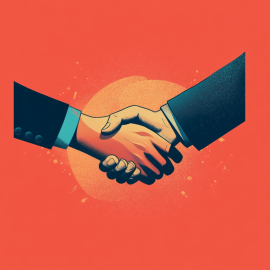

This article is an excerpt from the Shortform book guide to "Business Model Generation" by Alexander Osterwalder and Yves Pigneur. Shortform has the world's best summaries and analyses of books you should be reading.
Like this article? Sign up for a free trial here .
What is the multi-sided platform business model? How do companies that run on an MSP business model create value for their customers?
A multi-sided platform business model (MSP) is where a platform connects several distinct groups of customers with mutual interests. This business model is not a new development—it has existed for centuries. However, it started gaining prominence only in the last decade or so thanks to the advancement of the internet.
Keep reading to learn about the concept of the multi-sided platform business model and its key characteristics.
What Is the Multi-Sided Platform Business Model?
The Multi-sided platform business model enables direct interaction between two or more different but interdependent groups of customers. This pattern is most obvious in a marketplace such as Etsy—this business facilitates exchanges between buyers and sellers, and it requires participation from both parties to offer value and operate successfully. In other words, if sellers stopped listing items on Etsy, customers would see no value in visiting the site. If customers stopped shopping on Etsy, sellers would see no value in listing their products. The more active users that a platform can attract, the more value it can offer to both parties.
In their book Business Model Generation, Osterwalder and Pigneur suggest the following layout for multi-sided platform business models:
| Customer Groups | Focus on a minimum of two interdependent customer groups. |
| Value Offer | Value comes from the platform—it facilitates efficient and cost-effective interactions between the customer groups. |
| Touchpoints | Online methods are usually the most cost-effective. |
| Interactions | Online methods are usually the most cost-effective. The aim here is to facilitate interactions between the customer groups. |
| Profit Sources | Each group produces a different revenue stream depending on the fees they pay to use the platform (for marketplaces, sellers usually pay subscription fees while buyers have free access). |
| Resources | The more customers the platform can provide benefit to, the more of a resource it will become. |
| Critical Actions | Develop, maintain, and promote the platform to ensure it meets the needs of individual customer groups. |
| Network | Focus on developing partnerships that will make the platform more functional or attractive to all customer groups. |
| Expenses | Platform management and development will incur the highest costs. |
The Negative Impact of Network Effects on Sellers
Marketplaces are generally free for buyers to use—buyers only pay for the products and services they buy, not for using the platform. However, sellers are expected to pay various transactional fees for the benefits they receive from using these platforms, regardless of whether or not they make a sale. The platform promises to deliver them more attention, more visibility, and more opportunities to sell their products, and sellers are willing to pay for instant access to the platform’s global customer base.
As discussed, a multi-sided platform increases in value the more people use it. However, the more saturated these marketplaces become, the more difficult it is for sellers to stand out and attract the attention of buyers. In other words, the platform relies on having more sellers to function, but the more sellers it hosts, the more difficult it becomes for existing sellers to ensure the long-term viability of their business.
Over-saturation of the platform creates a high risk of sellers moving to other, more beneficial platforms. Sellers may no longer see the value in paying fees to be part of an over-saturated platform and end up switching to competing platforms that offer slightly different benefits (for example, different customer groups, varying fee structures, and transaction costs). Or they choose to use multiple platforms to expand their market reach and make more sales.
For example, consider Amazon Handmade and Etsy. Both platforms facilitate transactions between buyers looking for handmade products and sellers of handmade products, and they both offer slightly different fees and benefits. Handmade sellers can pick and choose between the two platforms (as well as multiple other handmade marketplaces) depending on the nature of their products and services, and the best return on their investment and time.

———End of Preview———
Like what you just read? Read the rest of the world's best book summary and analysis of Alexander Osterwalder and Yves Pigneur's "Business Model Generation" at Shortform .
Here's what you'll find in our full Business Model Generation summary :
- The nine elements that make up any successful business model
- Different ways you can combine these elements to create business model patterns
- Techniques you can use to generate innovative ideas






